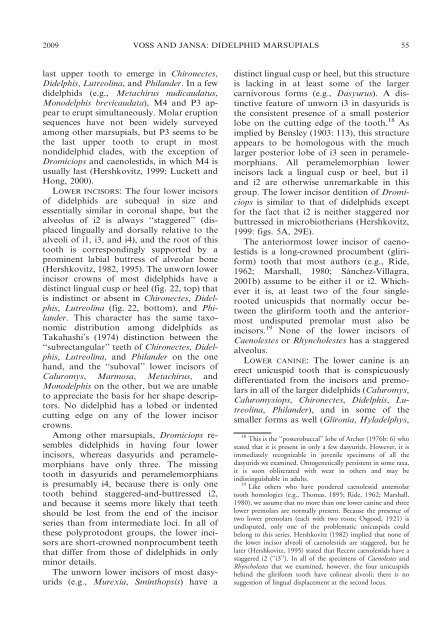phylogenetic relationships and classification of didelphid marsupials ...
phylogenetic relationships and classification of didelphid marsupials ...
phylogenetic relationships and classification of didelphid marsupials ...
Create successful ePaper yourself
Turn your PDF publications into a flip-book with our unique Google optimized e-Paper software.
2009 VOSS AND JANSA: DIDELPHID MARSUPIALS 55<br />
last upper tooth to emerge in Chironectes,<br />
Didelphis, Lutreolina, <strong>and</strong> Phil<strong>and</strong>er. In a few<br />
<strong>didelphid</strong>s (e.g., Metachirus nudicaudatus,<br />
Monodelphis brevicaudata), M4 <strong>and</strong> P3 appear<br />
to erupt simultaneously. Molar eruption<br />
sequences have not been widely surveyed<br />
among other <strong>marsupials</strong>, but P3 seems to be<br />
the last upper tooth to erupt in most<br />
non<strong>didelphid</strong> clades, with the exception <strong>of</strong><br />
Dromiciops <strong>and</strong> caenolestids, in which M4 is<br />
usually last (Hershkovitz, 1999; Luckett <strong>and</strong><br />
Hong, 2000).<br />
LOWER INCISORS: The four lower incisors<br />
<strong>of</strong> <strong>didelphid</strong>s are subequal in size <strong>and</strong><br />
essentially similar in coronal shape, but the<br />
alveolus <strong>of</strong> i2 is always ‘‘staggered’’ (displaced<br />
lingually <strong>and</strong> dorsally relative to the<br />
alveoli <strong>of</strong> i1, i3, <strong>and</strong> i4), <strong>and</strong> the root <strong>of</strong> this<br />
tooth is correspondingly supported by a<br />
prominent labial buttress <strong>of</strong> alveolar bone<br />
(Hershkovitz, 1982, 1995). The unworn lower<br />
incisor crowns <strong>of</strong> most <strong>didelphid</strong>s have a<br />
distinct lingual cusp or heel (fig. 22, top) that<br />
is indistinct or absent in Chironectes, Didelphis,<br />
Lutreolina (fig. 22, bottom), <strong>and</strong> Phil<strong>and</strong>er.<br />
This character has the same taxonomic<br />
distribution among <strong>didelphid</strong>s as<br />
Takahashi’s (1974) distinction between the<br />
‘‘subrectangular’’ teeth <strong>of</strong> Chironectes, Didelphis,<br />
Lutreolina, <strong>and</strong> Phil<strong>and</strong>er on the one<br />
h<strong>and</strong>, <strong>and</strong> the ‘‘suboval’’ lower incisors <strong>of</strong><br />
Caluromys, Marmosa, Metachirus, <strong>and</strong><br />
Monodelphis on the other, but we are unable<br />
to appreciate the basis for her shape descriptors.<br />
No <strong>didelphid</strong> has a lobed or indented<br />
cutting edge on any <strong>of</strong> the lower incisor<br />
crowns.<br />
Among other <strong>marsupials</strong>, Dromiciops resembles<br />
<strong>didelphid</strong>s in having four lower<br />
incisors, whereas dasyurids <strong>and</strong> peramelemorphians<br />
have only three. The missing<br />
tooth in dasyurids <strong>and</strong> peramelemorphians<br />
is presumably i4, because there is only one<br />
tooth behind staggered-<strong>and</strong>-buttressed i2,<br />
<strong>and</strong> because it seems more likely that teeth<br />
should be lost from the end <strong>of</strong> the incisor<br />
series than from intermediate loci. In all <strong>of</strong><br />
these polyprotodont groups, the lower incisors<br />
are short-crowned nonprocumbent teeth<br />
that differ from those <strong>of</strong> <strong>didelphid</strong>s in only<br />
minor details.<br />
The unworn lower incisors <strong>of</strong> most dasyurids<br />
(e.g., Murexia, Sminthopsis) have a<br />
distinct lingual cusp or heel, but this structure<br />
is lacking in at least some <strong>of</strong> the larger<br />
carnivorous forms (e.g., Dasyurus). A distinctive<br />
feature <strong>of</strong> unworn i3 in dasyurids is<br />
the consistent presence <strong>of</strong> a small posterior<br />
lobe on the cutting edge <strong>of</strong> the tooth. 18 As<br />
implied by Bensley (1903: 113), this structure<br />
appears to be homologous with the much<br />
larger posterior lobe <strong>of</strong> i3 seen in peramelemorphians.<br />
All peramelemorphian lower<br />
incisors lack a lingual cusp or heel, but i1<br />
<strong>and</strong> i2 are otherwise unremarkable in this<br />
group. The lower incisor dentition <strong>of</strong> Dromiciops<br />
is similar to that <strong>of</strong> <strong>didelphid</strong>s except<br />
for the fact that i2 is neither staggered nor<br />
buttressed in microbiotherians (Hershkovitz,<br />
1999: figs. 5A, 29E).<br />
The anteriormost lower incisor <strong>of</strong> caenolestids<br />
is a long-crowned procumbent (gliriform)<br />
tooth that most authors (e.g., Ride,<br />
1962; Marshall, 1980; Sánchez-Villagra,<br />
2001b) assume to be either i1 or i2. Whichever<br />
it is, at least two <strong>of</strong> the four singlerooted<br />
unicuspids that normally occur between<br />
the gliriform tooth <strong>and</strong> the anteriormost<br />
undisputed premolar must also be<br />
incisors. 19 None <strong>of</strong> the lower incisors <strong>of</strong><br />
Caenolestes or Rhyncholestes has a staggered<br />
alveolus.<br />
LOWER CANINE: The lower canine is an<br />
erect unicuspid tooth that is conspicuously<br />
differentiated from the incisors <strong>and</strong> premolars<br />
in all <strong>of</strong> the larger <strong>didelphid</strong>s (Caluromys,<br />
Caluromysiops, Chironectes, Didelphis, Lutreolina,<br />
Phil<strong>and</strong>er), <strong>and</strong> in some <strong>of</strong> the<br />
smaller forms as well (Glironia, Hyladelphys,<br />
18 This is the ‘‘posterobuccal’’ lobe <strong>of</strong> Archer (1976b: 6) who<br />
stated that it is present in only a few dasyurids. However, it is<br />
immediately recognizable in juvenile specimens <strong>of</strong> all the<br />
dasyurids we examined. Ontogenetically persistent in some taxa,<br />
it is soon obliterated with wear in others <strong>and</strong> may be<br />
indistinguishable in adults.<br />
19 Like others who have pondered caenolestid antemolar<br />
tooth homologies (e.g., Thomas, 1895; Ride, 1962; Marshall,<br />
1980), we assume that no more than one lower canine <strong>and</strong> three<br />
lower premolars are normally present. Because the presence <strong>of</strong><br />
two lower premolars (each with two roots; Osgood, 1921) is<br />
undisputed, only one <strong>of</strong> the problematic unicuspids could<br />
belong to this series. Hershkovitz (1982) implied that none <strong>of</strong><br />
the lower incisor alveoli <strong>of</strong> caenolestids are staggered, but he<br />
later (Hershkovitz, 1995) stated that Recent caenolestids have a<br />
staggered i2 (‘‘i3’’). In all <strong>of</strong> the specimens <strong>of</strong> Caenolestes <strong>and</strong><br />
Rhyncholestes that we examined, however, the four unicuspids<br />
behind the gliriform tooth have colinear alveoli; there is no<br />
suggestion <strong>of</strong> lingual displacement at the second locus.

















